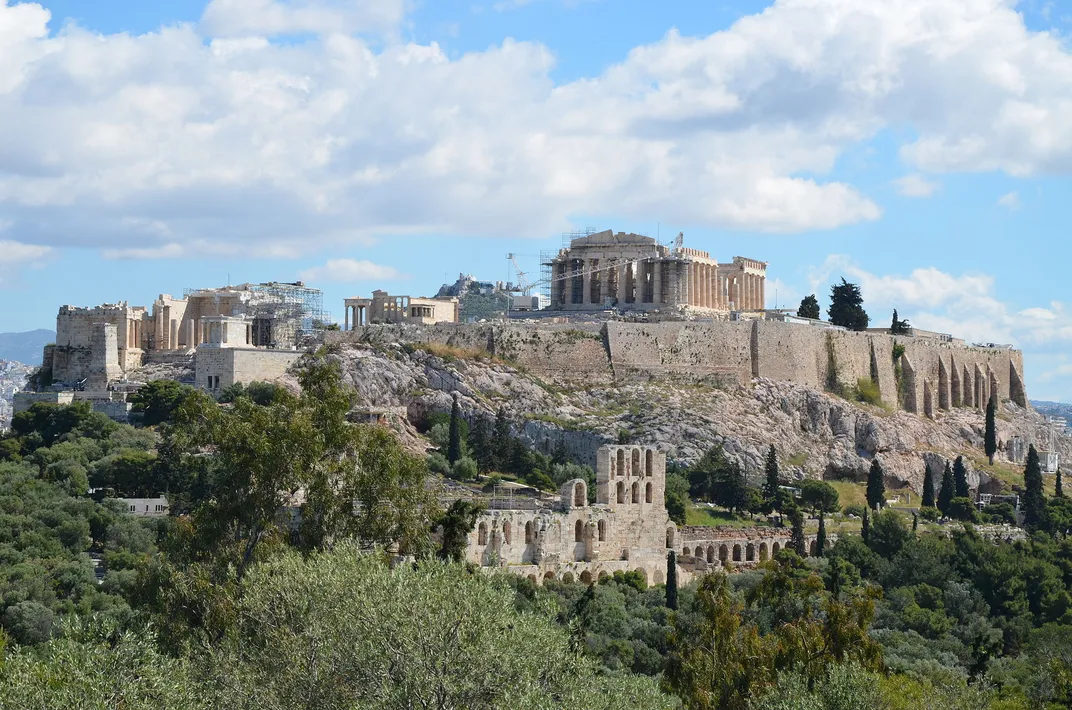Why Proposed Renovations to Greece’s Acropolis Are So Controversial
Scholars voiced concern about planned aesthetic changes and a lack of adequate accessibility measures for people with disabilities
:focal(2362x1346:2363x1347)/https://tf-cmsv2-smithsonianmag-media.s3.amazonaws.com/filer/ff/06/ff06df77-7787-4f58-98fa-c1ba28e9874b/restoration_work_parthenon_facade_acropolis_athens_greece.jpeg)
Ongoing and proposed renovations at Greece’s Acropolis of Athens have sparked much controversy in the archaeological community, reports William Summerfield for the Art Newspaper.
The Mediterranean nation’s Ministry of Culture and Sports has overseen periodic and ongoing renovations at the ancient Greek heritage site since 1975, according to its website. Last year, the ministry proposed a series of major structural changes to the site, which is home to some of the highest-trafficked and most famous classical ruins in the world, including the Parthenon and the Temple of Athena Nike.
Suggested renovations ranged from the addition of cement paving throughout the historic site, much of which has since been completed, to the reconstruction of a Roman marble staircase on the Acropolis’ western side. The new staircase will form part of a major overhaul to the Propylaea, a monumental entrance hall designed by ancient Greek architect Mnesicles around 437 B.C., per Encyclopedia Britannica.
As the Art Newspaper notes, Manolis Korres, president of the Acropolis Monuments Conservation Committee, is overseeing the project, which was approved by the Greek Central Archaeological Council in February. (After closing for nearly five months during the Covid-19 pandemic, the Acropolis and other open-air archaeological sites in Greece reopened to the public on March 21, according to Artnet News.)
The plan has attracted marked backlash from the academic community. In February, dozens of scholars, artists and lawyers signed an open letter sharply criticizing the proposed structural changes to the Unesco World Heritage site. The signees argued that the changes to the Acropolis go far beyond “restoration,” and instead represent large-scale, historically inaccurate additions that defy international protocol for historic preservation.
Per a translation by Artnet News, the letter’s authors described the proposed changes to the Propylaea as “equivalent to the degradation, concealment, and devaluation of the greatest archaeological and artistic treasure that has been bequeathed to modern Greece.”
Last December, they added, heavy rains led to flooding at the Acropolis—conditions that were likely exacerbated by the newly installed paving.

Activists for people with disabilities also argue that the cement pathways, many of which have already been added in and around the rocky summit, do not measure up to officials’ promises of accessibility. Just this month, writes Paula Tsoni for the Greek Reporter, a man using a wheelchair fell and injured his face while traversing the renovated site, prompting renewed criticism that the paths do not adequately meet standard accessibility criteria. (For what it’s worth, recent research suggests that some Greek temples, particularly those associated with healing rituals, originally boasted ramps that ensured individuals with impaired mobility could access the sacred sites, as Laura Geggel reported for Live Science last year.)
The online news site Television Without Borders has compiled a list of additional complaints against the new site, including too-sleep slopes for wheelchair users, a lack of handrails and no easy-access parking spots for people with disabilities.
Speaking with Greek newspaper Avgi, per a translation by the Greek Reporter, the president of the Greek Archaeologists Union, Despina Koutsoumba, condemned the renovations.
“The goal [of these works] is to turn the Acropolis into a place of mass tourism at all costs for the monument,” she says.
In a separate opinion piece for Avgi, Yannis Hamilakis, an archaeologist at Brown University, argues that the designs for reconstructions of the Propylaea are not historically accurate, but rather amount to a “radical remodeling” based on romanticized 18th- and 19th-century notions of Greek antiquity, per Google Translate.
“In reality, it is not the [fifth] century that is being rebuilt faithfully on the Acropolis, whose monuments … are the subject of wide discussion among experts,” the scholar writes. “If it were, all its buildings would have to be painted in different colors.”
The ancient Greeks famously incorporated bright, bold colors into their statues and temples, but this paint often wore off over the centuries, leaving only marble. It was only during the Renaissance and after that European scholars perpetuated the popular misconception that ancient artists carved exclusively in shades of white, as historian Sarah E. Bond wrote for Hyperallergic in 2017.
Hamilakis adds, “What is being reconstructed is an Acropolis of whiteness, of the Euro-centric, Western fantasy; an Acropolis as built by philologists, architects and archaeologists in the 18th and 19th centuries; an Acropolis of colonial-national modernity and romantic nationalism.”
/https://tf-cmsv2-smithsonianmag-media.s3.amazonaws.com/accounts/headshot/nora.png)
/https://tf-cmsv2-smithsonianmag-media.s3.amazonaws.com/accounts/headshot/nora.png)